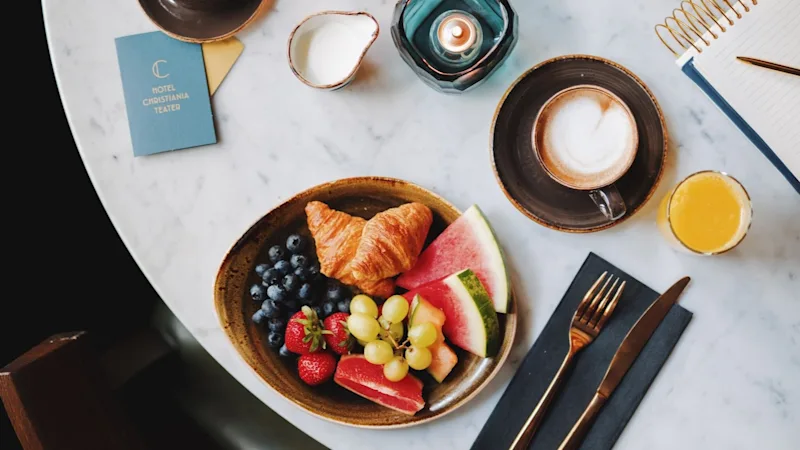Brutally Simple: Stockholm's New Star Restaurant
A social experiment, extreme minimalism, a world-famous artist, a celebrity hangout, and a manifesto. What's the story behind the restaurant Brutalisten?
Strawberry asked people on the streets of Stockholm: What is a place on the capital's restaurant scene is on everyone's lips right now?
"Brutalisten!" comes the confident reply from a man in his 30s.
"It's a new restaurant started by the artist Carsten Höller. Miuccia Prada has already dined there," he name-drops enthusiastically.
The consensus among those we asked is that this is a place everyone is talking about now.
The Experimental Artist Behind Brutalisten
Brutalisten is a restaurant located a short walk from the 5-star At Six Hotel - right in the heart of vibrant Stockholm. The New York Times called Brutalisten a dining spot, social experiment, and celebrity magnet.
Here, the aforementioned fashion giant Prada has already dined, as well as other celebrities including director Jonas Åkerlund, Acne Studios' Mikael Schiller, and model and Creative Director for Swarovski Group, Giovanna Battaglia Engelbert.
The Allure of Brutalisten
Although the restaurant quickly became a hot topic in the capital and beyond, there is still an air of mystery surrounding its concept. The website reveals little about the menu, besides "The Brutalist Kitchen Manifesto". The man behind it all, experimental artist Carsten Höller, is busy with major exhibitions and has no time for interviews.
Luckily, award-winning chef Stefan Eriksson, who has also been involved in creating the menu at Brutalisten, is available for a Q&A!
Stefan has 32 years of experience in the kitchen and has previously been named Chef of the Year and Swedish Kitchen Champion. He not only answers all our questions about the new concept, but he even gives us a taste of several dishes. It's an experience that can be summed up as peculiar and raw. Or somewhat brutal...
Let's Go: What attracted you to Brutalisten?
"I've always enjoyed cooking, especially when it's based on a specific idea. I've known Carsten for 15 years, and when he presented me with the manifesto... well, there's nothing more appealing to me than cooking in this very way," says Stefan.
"The manifesto focuses on the producer, the fisherman, and the farmer, and their ingredients. And it's these ingredients that are the most important detail. That's what it's all about."
To illustrate, Stefan says that all types of shellfish are beautiful and tasty, and that the fantastic thing is what nature has created in itself. There's no need to add anything extra.
At Brutalisten, the entire ingredient is used, and only that ingredient, in a single dish.
The chef believes that it's actually that simple - if you have good milk, you can make an incredible cheese, but if you don't have good milk, you won't have good cheese.
Using Just One Ingredient
"For example, if you take a pumpkin, you can use the seeds to make oil, ferment the pumpkin flesh or grill it – then you have a dish that's one hundred percent pumpkin. Nothing else."
"And there's something fundamental about this, as if one is dealing with the basics in the brutalist way of thinking."
This is where point six from the manifesto comes in: "A single ingredient is often divided up and prepared in several different ways, before being served on the same plate."
In total, Carsten's way of thinking consists of a 13 point manifesto whereby the cooking abides by the following principles, among others:
"The title, The Brutalist Kitchen, is a reference to brutalist architecture, known for its linear and block-like appearance."
"The main rule is as follows: Ingredients are used alone for a specific dish; only water and salt may be added."
"We are born as brutalist eaters, since breast milk is primarily brutalist."
"The world of food is so fake and contrived, always trying to invent something new and extra, it becomes so artificial. At Brutalisten, it's down to earth, there's respect for the producer and understanding for the farmer – and I love that."
This means that Stefan makes broth from the bones of the ox, fish, or bird that's used in the main course. Fermented juices are made from vegetables, and everything is kept as simple as possible.
Can you describe a typical evening here?
"We are an à la carte restaurant with many different dishes and ingredients, where you decide how you want to eat. You choose the dishes you want and the order in which you want them to be served. We create a palette of flavours and ingredients, and everything is up to the guests themselves. I think that's nice."
What an evening is like here will naturally depend on the clientele, Stefan points out. Some days it's quiet, while on others there's a real party atmosphere. As for the restaurant's popularity, he doesn't have a good explanation, but believes it's because Brutalisten is different from everything else. The food makes you think. It's a bit strange and new.
"Also, Carsten is very fond of Congolese music, which is delicious and dynamic music. So, it's Carsten's ideas, input, lots of food - grilling, serving Swedish wines, and the evenings being an overall beautiful mix of the whole package that I find special."
What's Carsten Höller like?
"He's incredibly enriching, fun, and open-minded. He's good with food and ingredients, and if he experiences something, he can ask if we can do it. For example, he might come and ask what happens if we let a squid lie in its own stomach acid for three days? Or he might bring in a wild goose that a friend has hunted and ask: what can we make from it? Carsten gets everyone around him to think differently, and he is constantly inspiring us," Stefan explains.
But what does art actually have to do with food?
"Well... that's a good question. I recently read that 'art makes one think for oneself'' and I like that idea. Art allows you to take many paths and do things in different ways. And this can be connected to food because it's often so confined and people forget to think for themselves. We tend to follow what we see on Instagram or create dishes based on the ingredients available from the big suppliers, without really thinking," Stefan explains, before continuing:
"And that's where we conceptual art plays in – the idea that I like to cook based on a concept. The Brutalist Kitchen is precisely that: take an idea and a way of thinking and see what happens. I love that!"
While Stefan has been chatting with us, we have been served both meat and fish, and we also received a friendly tip from the waiter with a smile: You have to ask outright: "What the hell are we eating?"
About the menu at Brutalisten
We actually did have to ask.
There is dry-aged fish on one plate and beef with broth from the ox bone, complemented by a caramelised cheese sauce, on another.
Our conclusion was that this is food that is just as Stefan described it: quirky, extremely dedicated, Nordic, and homemade.
Familiar flavours from the sea and the dairy, but much, much better tastes.
Intense and pure. Thought-provoking.
About Carsten Höller
- Born in 1961 in Belgium
- Works and lives in Stockholm, Sweden
- Carsten Höller is best known for "Test Site", a series of giant slides for Tate Modern's Turbine Hall, Amusement Park, which is an installation of full-sized carousels moving at a slow pace at MASS MoCA in North Adams, Massachusetts. In 2015 he created Decision at Hayward Gallery, where the building was transformed into an experimental journey with two entrances and four exits – two of the exits were slides.
- Carsten Höller has a background as a researcher and his art examines scientific curiosity and human behaviour.
- Opened Brutalisten in May 2022
*(Sources: Wikipedia, Henie Onstad Art Centre) *


